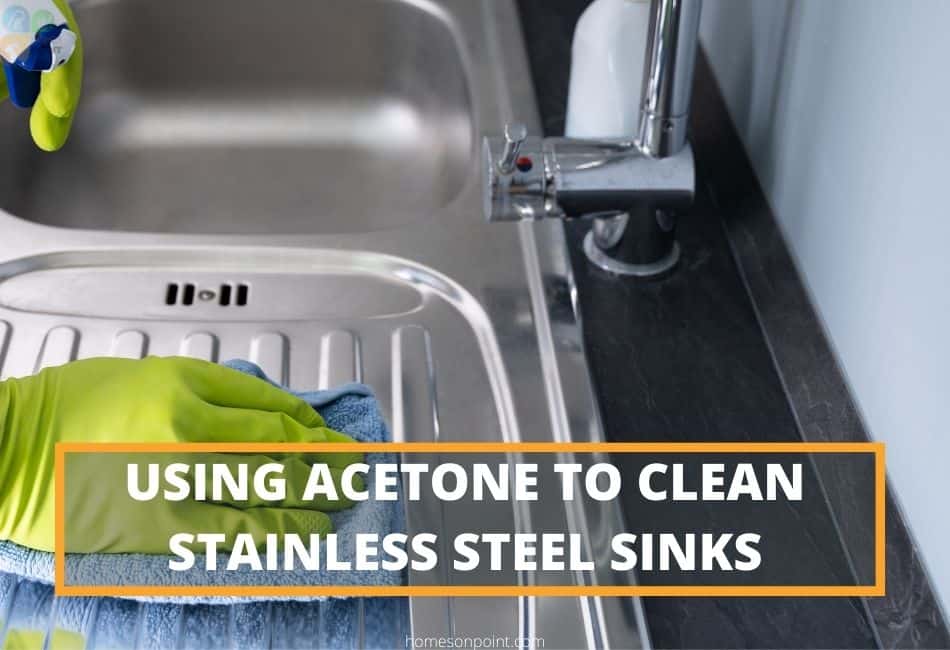When it comes to cleaning stainless steel sinks, there are a lot of different opinions on what works best. The truth is many people try a lot of different cleaning solutions and methods in an attempt to find the perfect one for their needs. Some use natural home remedies such as using normal dish soap and water while others prefer to use more heavy-duty cleaners such as magic erasers or oven cleaners to clean their stainless steel sinks.
However, there is one cleaner that some people use to clean their stainless steel sink that needs to be examined whether it is safe to use or not, acetone. Some people say that acetone is the best way to clean stainless steel sinks, while others say it’s a terrible idea. So, what’s the truth? Can you use acetone to clean stainless steel sinks?
The simple answer is yes, acetone can be used to clean stainless steel sinks but it will leave streaks on your sink which can attract other dirt and grime. The streaks will normally disappear with use but they will come back if acetone is used again to clean the sink.
While acetone is effective at cleaning, there are some things to consider before using acetone on your stainless steel sink. But then, let’s look at what acetone is and what it is used for.
What Is Acetone?
Acetone is a chemical solvent that is most commonly used as an industrial cleaner and degreaser. It is also a common ingredient in many household cleaners, nail polish removers, and paints. Acetone is a colorless liquid with a strong smell that evaporates quickly. It is also flammable and should be used with caution.
Acetone is a very strong solvent and can be used to remove things like paint, grease, and adhesive. It’s also very effective at removing dirt and grime. Acetone is often used as a cleaning solution because it is effective and relatively inexpensive.
Now that we know what acetone is, let’s discuss some things to consider before using acetone on your stainless steel sink.
Things To Consider Before Using Acetone On Your Stainless Steel Sink
acetone is a powerful solvent that can be used to clean many surfaces. However, there are some things you should consider before using acetone to clean stainless steel sinks.
1. Don’t Use Acetone As Your Regular Cleaner
Acetone is a powerful solvent and should only be used occasionally to clean your stainless steel sink to remove stubborn stains from your sink. If you use acetone too often, it will remove the protective layer on your sink and make it more susceptible to rust and corrosion. It may look good when used the first, second, or even the third time but you are going to eventually see scratches developing on your stainless steel sink.
2. Avoid Abrasive Scrubbers And Scrubbing Too Hard
When cleaning with acetone, avoid using abrasive scrubbers such as steel wool or scouring pads. These can scratch the surface of your sink and make it more susceptible to rust and corrosion. Instead, use a soft cloth or sponge when cleaning with acetone and rinse right away with clean water.
In the same way, when using non-abrasive scrubbers, don’t scrub too hard as this can also damage the surface of your stainless steel sink. Acetone is already a powerful solvent and doesn’t need any help from you to do its job. Combining that with hard scrubbing will only increase the chances of damaging your sink.
3. Don’t Allow Acetone To Sit On Your Sink For Too Long
Acetone is a powerful solvent and can remove the protective layer on your stainless steel sink if allowed to sit for too long. When using acetone, work in small areas and rinse right away with clean water. The longer it stays, the more damage it can cause.
As a rule of thumb, always test acetone in a small, inconspicuous area of your sink before using it on the entire surface. This will allow you to see how acetone reacts with your sink and if there are any adverse effects.
Now that we’ve discussed some things to consider before using acetone, let’s take a look at some pros and cons of using acetone to clean your stainless steel sink.
Pros Of Using Acetone To Clean Stainless Steel Sinks
1. Effective Cleaner And Degreaser
Acetone is an effective cleaner and degreaser and can be used to remove dirt, grease, and grime from your stainless steel sink. They are designed to break down and remove tough stains quickly and easily. They easily remove things like adhesive, paint, and other stubborn stains from your sink.
Apply acetone in small areas and scrub with a soft cloth or sponge. Rinse right away with clean water and dry with a clean towel.
2. Acetone Is Easy To Use
One thing about acetone is that it is very easy to use and doesn’t require any special skills or knowledge to use it effectively. Simply apply acetone to the surface you want to clean, scrub with a soft cloth or sponge, and rinse with clean water. It’s as simple as that.
3. Acetone Is Inexpensive
Acetone is a very inexpensive cleaning solution and can be found at most hardware stores or online. A little acetone goes a long way so you don’t need to use much of it to clean your stainless steel sink.
Cons Of Using Acetone To Clean Stainless Steel Sinks
While acetone has its pros, there are also some cons to using acetone to clean your stainless steel sink. Let’s take a look at some of those now.
1. Improper Use Of Acetone Can Damage Your Stainless Steel Sink
Acetone is a powerful solvent and can easily damage your stainless steel sink if not used properly. If used too much or too often, or when left to sit on the sink for a long time, it can remove the protective layer on your sink exposing the bare metal underneath to rust and corrosion.
After drying, acetone leaves streaks on the surface of your sink which may or may not go away with use unless you buff it.
To avoid damaging your stainless steel sink, test acetone in small areas and rinse right away. In this case, if acetone is going to damage your sink, it will only do so in the small test area and you’ll know right away.
2. Acetone is flammable
Acetone is a flammable solvent and should be used with caution. It can easily catch fire if exposed to an open flame or spark.
There are several reasons why acetone is so flammable. First, it has a very low flash point, which means that it can easily ignite at relatively low temperatures. Additionally, acetone is highly volatile, meaning that it vaporizes readily at room temperature. When exposed to heat or an open flame, the vaporized acetone can quickly catch fire.
When using acetone, make sure to use it in a well-ventilated area and keep it away from any open flames.
3. Acetone Can Be Toxic If ingested
Acetone is a toxic solvent and can be harmful if ingested. When acetone evaporates, it releases harmful chemicals into the air. These chemicals can cause a variety of health problems, including eye irritation, headaches, and dizziness. Inhaling large amounts of acetone can also lead to unconsciousness.
Be sure to keep it out of reach of children and pets. Always wear protective gear, such as gloves and a mask, when using acetone.
4. Acetone Has A Strong Smell
Acetone has a strong, unpleasant smell that can be overpowering. The reason for this is that acetone is a volatile organic compound (VOC). VOCs are chemicals that easily evaporate into the air, and they are often used in products that need to be diluted or removed quickly.
The strong smell of acetone can be a nuisance, and it can also be dangerous if inhaled in large quantities. When possible, use them in well-ventilated areas and make sure to follow the manufacturer’s instructions carefully. Always wear a mask when using acetone to avoid inhaling the fumes.
Alternatives To Acetone For Cleaning Stainless Steel Sinks
Now that we have examined some of the pros and cons of using acetone to clean your stainless steel sink, let’s take a look at some alternatives.
Baking Soda And Lemon
One alternative to acetone is to mix baking soda and lemon. Baking soda is a mild abrasive that can help remove tough stains, while lemon is a natural disinfectant. The reaction between the two will remove dirt and grime without damaging your sink. To use this method;
- Step 1: Sprinkle some baking soda over the surface of your stainless steel sink and use a soft sponge to spread it around. Before sprinkling the baking soda, make sure the surface of the sink is wet.
- Step 2: Cut the lemon in half and squeeze the juice over the baking soda. This will start a fizzling reaction. Use the cut lemon halves to rub the surface of your sink and leave it to sit for about 10 minutes.
- Step 3: After 10 minutes, rinse the sink with clean water while rubbing the surface with a soft sponge.
- Step 4: Use a clean microfiber cloth to dry the sink completely.
Vinegar And Water
Another alternative to acetone is vinegar and water. Vinegar is a natural acid that can break down dirt, grime, and soap scum. It is also a natural disinfectant. To use this method;
- Step 1: Mix equal parts vinegar and water in a spray bottle.
- Step 2: Spray the vinegar solution onto the entire surface of your stainless steel sink
- Step 3: Leave the solution on your sink for about 15 minutes to allow it to work its magic.
- Step 4: After 15 minutes, rinse the sink with clean water and dry completely with a microfibre cloth.
Final Words
Most stainless steel sinks are not made with 100% stainless steel. They are made with normal metal and coated with a thin sheet of stainless steel. This means that improper cleaning and using harsh chemicals can damage the thin coat of stainless steel.
As you can see, there are some pros and cons of using acetone to clean your stainless steel sink. acetone is a powerful solvent that can remove tough stains quickly, but it can also be dangerous if not used properly. There are some alternatives to acetone that are just as effective and much safer to use like vinegar, baking soda and lemon.
If you do decide to use acetone, be sure to take the necessary precautions and always follow the manufacturer’s instructions. Always wear gloves and a mask and work in a well-ventilated area. Acetone is a powerful chemical and should be used with caution. Happy cleaning.

